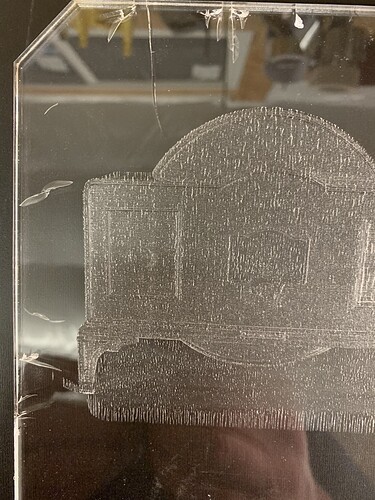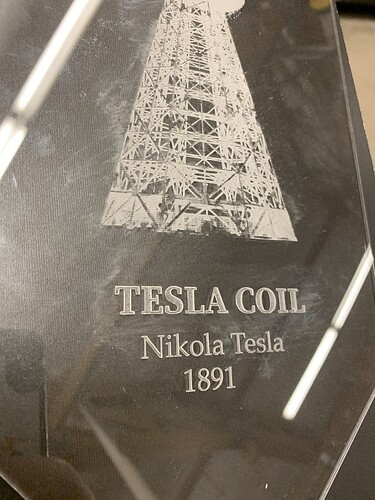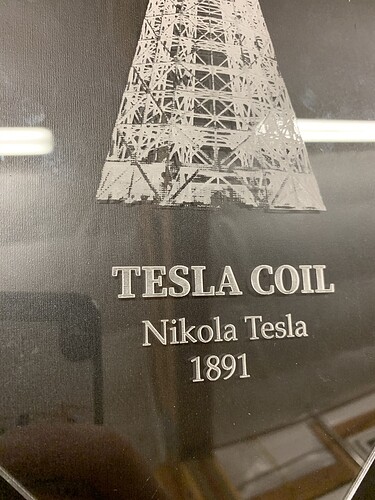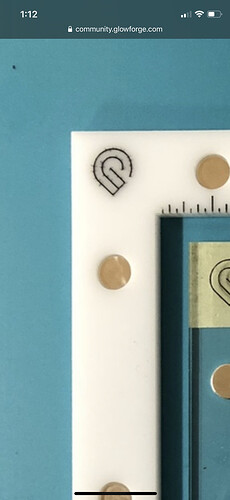Just in case there was any doubt, here’s what happens when you clean cast acrylic with alcohol
Acetone works wonders!
The effect is called “crazing”, and it’s why you don’t use alcohol on acrylic. Bummer.
There have been other discussions on the forum and elsewhere (google) about how it works, it’s a sure way to screw up a piece of plexi.
I need some help with this. I’m engraving 5/16 cast acrylic for LED edge display. The engraving works great, but no matter how hard I try, I can’t get the streaks or fog out of the acrylic. I have done a lot of searching here, and some of the things people swear by don’t work at all (alcohol) some swear by acetone, while other say “DON’T USE ACETONE!” I’ve also seen toothpaste, magic eraser, simple green, goo gone, the list goes on. I’ve tried it all. I’ve tried engraving with and without masking, doesn’t seem to make a lot of difference, (although with masking does seem to leave a lot more glue residue in the engraved areas). I’d love to hear from some of you who have discovered the secret. Thanks!
Acetone worked great for me.
Use a cleaner designed for acrylic/plastic. Pro fabricators use one of these (also never use Windex on acrylic)
Novus 7100 Plastic Polish Kit - 8 Ounce
Ive tried Novus 1&2. With a tremendous amount of elbow grease it makes a dent, but doesn’t entirely remove it. I’m beginning to wonder if this stuff I bought as cast is actually is extruded… from what I’ve read the hazing is more of a problem with extruded, and no one seems to be having the difficulty I am. I’ll try engraving one of these on PG acrylic & see if there is a difference.
Sometimes, depending on the level and shape of scratch, a very soft polishing wheel in a rotary tool plus the Novus can work.
OK, i ran the same job on PG acrylic and i get the same results. I don’t get it, why does it take me 30 mins to get all the haze off of these? I don’t hear anyone else having this problem.
What haze are you referring to?
If you’re engraving with the paper masking still on the acrylic, you wont have anything (or at least very little) that needs to be cleaned off.
If soap and warm water don’t wash it off then you need a cleaner/polish for acrylics and a polishing wheel.
Do NOT use ANY kind of solvent… alcohol, denatured alcohol, acetone, mineral spirits, etc. to clean acrylic.
If Novus isnt working maybe Brillianize will.
There is a photograph of the hazing further up in the thread. But I solved the problem. According to the plexiglass.com website the best cleaner for acrylic is Naphtha. They specifically say not to use acetone, alcohol, the list goes on.
Below is a photograph with the hazing, and then another photograph after wiping with Naptha.
Interesting! Thanks for reporting back!
I made some acrylic engraved lights as Christmas presents, I found that the base slot in the light was too narrow for the tongue that I cut at the bottom of the acrylic, after etching it down, I did not like the hazed effect, cleaners did not help, so I hit it with the heat of a butane torch to get it almost see through again, worked well.
I wonder why they say not to use acetone. I have used it, with great results, based on a thread I found here, let me see if I can find it. Here it is:
I will say I was using it on colored acrylic, not clear. I wonder if it makes a difference.
From what I have heard, it is Isopropyl alcohol that causes the crazing. Denatured alcohol has Isopropyl as a part of the denaturing, As best I can tell the alcohol hand sanitizer does not cause crazing but dissolves most of the organics caused by the laser or any of the masking adhesives (and also the glue from MDF  )
)
I have left pieces in the sanitizer till the masking floated away without crazing, Another thing to try is the alcohol wipes for the lenses.
Denatured is just ethanol with added stuff to make it taste bad, in order to prevent human consumption (and thereby not lose on out liquor taxes). It’s called Methylated Spirits in much of the world (and is usually colored.)
Isopropanol is just an alcohol molecule that stays in suspension with other solutions (i.e. water) so it can be consistently diluted.
Acetone is a similar molecule that also has that property.
They are all chemical solvents and if you dig into it, you will find instances where all of them have caused crazing or cracks on acrylic.
It’s not a science, it appears it depends on your specific material and the solvent you use.
Be cautious with it, too. Acetone can cause some unwanted changes to the surface of some acrylics, too!
Acetone can cause crazing or full on fracturing depending on what material you are using.
Extruded acrylic is very susceptible to acetone damage. Cast acrylic, not as much, but if you use it near edges, it can cause issues. I use it to get rid of glue or hazing on cast sometimes, but I take care to be very tidy in the process.
If you look at the following picture, I was using a sharpie to fill in this Glowforge symbol on some white cast acrylic, and then wipe the sharpie off the top using acetone. You can see the micro-fractures in the symbol from that process.
It’s just something you have to test and get a feel for.
I’ve been able to get around this problem when using no masking by going fast enough, with the right amount of power to where it doesnt deposit melted acrylic back onto the piece.
I want to say I was using 1000 speed and 70 power. It etches the surface enough to leave a mark, but no sticky residue. I know I adjusted this to work at 2000 speed as well. It might be 2000 speed/100 power(not full power) with no masking. Saves so much weeding time.
Thanks very much to everyone that contributed to this thread. I’m now successfully producing clean & clear acrylic displays. This group is fantastic!



